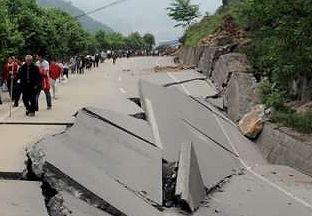
For hundreds of years people have been reporting unusual animal behavior prior to earthquakes. Now, scientists say that it may be caused by rock deformations in the Earth’s crust which release charged particles that then react with groundwater. The findings, by an international team of researchers led by Friedemann Freund from NASA, appear in the International Journal of Environmental Research and Public Health.
How animals might be able to sense impending seismic events has been the subject of much discussion in the past, with theories that included ultralow frequency electromagnetic emissions from the ground, luminous phenomena (earthquake lights), changes in the atmosphere near the ground or changes in water chemistry.
The new theory stems from serendipitous research conducted by Rachel Grant of the Open University (UK) on a colony of toads in L’Aquila, Italy, in 2009. Days before an earthquake struck the area, Grant observed the toad population abandon the pond. After publishing her observations she was contacted by Freund who had been conducting research into the chemical changes that occur when rocks are under extreme stress. Freund believed the mass exodus of the toads might be linked to a previously unknown form of electrification that he had observed when rocks are subjected to mechanical stress.
Freund explained that when tectonic stresses build up in the Earth’s crust, highly mobile electronic charge carriers are activated. These charge carriers are defect electrons on the oxygen anion sublattice of silicate minerals (known as positive holes). “They are remarkable inasmuch as they can flow out of the stressed rock volume and spread into the surrounding unstressed rocks. Travelling fast and far the positive holes cause a range of follow-on reactions when they arrive at the Earth’s surface,” he notes.
“The process at the rock-water interface consists of changes in the groundwater and presumably lake water chemistry, which seems to have provided the toads with an impetus to leave and seek refuge on higher ground. Thus, the toads [reacted] to cues that resulted from chemical reactions at the ground-water interface, which were driven by the arrival of stress-activated charge carriers from deep below,” Freund explains.
As well as affecting groundwater, the tectonic-stress created ions are also released into the atmosphere. Freund suggests that these positive airborne ions can cause blood serotonin levels to increase in both humans and animals. “Changes in the serotonin levels as a result of a pre-earthquake injection of positive airborne ions into the Earth’s near-surface atmosphere may be instrumental in causing the widely reported anomalous behavior of land animals prior to major earthquakes [and] causing an increase in migraine incidences in humans.”
The new findings represent a possible common mechanism for the diverse range of pre-earthquake incidents of anomalous animal behavior and may be of use in future research aimed at forecasting earthquake risks.
Related:
Discuss this article in our forum
Quake detection gets cheap and cheerful
Midwest still shakin’ all over – 200 years later
Under Pressure: Earth Science
Bacteria Used To Reinforce Buildings


















Comments are closed.